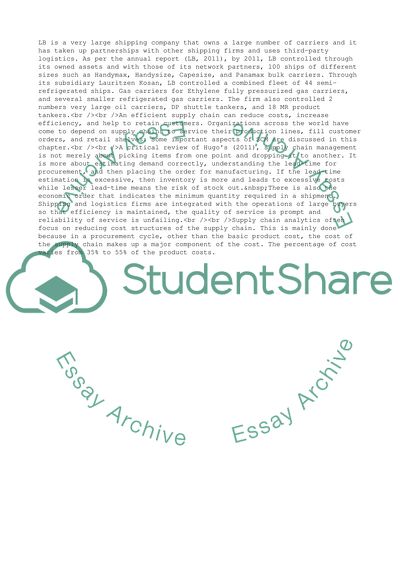Cite this document
(Supply Chain Management: Lauritzen Bulkers Case Study Example | Topics and Well Written Essays - 1500 words, n.d.)
Supply Chain Management: Lauritzen Bulkers Case Study Example | Topics and Well Written Essays - 1500 words. https://studentshare.org/management/1770398-identify-and-discuss-the-change-of-activity-and-costs-structure-within-the-supply-chain-iflb-looked-to-a-third-party-logistics-provider-to-supply-their-transport-needs-to-what-extent-would-this-facilitate-lb-in-gaining-iso-14000-recognition
Supply Chain Management: Lauritzen Bulkers Case Study Example | Topics and Well Written Essays - 1500 words. https://studentshare.org/management/1770398-identify-and-discuss-the-change-of-activity-and-costs-structure-within-the-supply-chain-iflb-looked-to-a-third-party-logistics-provider-to-supply-their-transport-needs-to-what-extent-would-this-facilitate-lb-in-gaining-iso-14000-recognition
(Supply Chain Management: Lauritzen Bulkers Case Study Example | Topics and Well Written Essays - 1500 Words)
Supply Chain Management: Lauritzen Bulkers Case Study Example | Topics and Well Written Essays - 1500 Words. https://studentshare.org/management/1770398-identify-and-discuss-the-change-of-activity-and-costs-structure-within-the-supply-chain-iflb-looked-to-a-third-party-logistics-provider-to-supply-their-transport-needs-to-what-extent-would-this-facilitate-lb-in-gaining-iso-14000-recognition.
Supply Chain Management: Lauritzen Bulkers Case Study Example | Topics and Well Written Essays - 1500 Words. https://studentshare.org/management/1770398-identify-and-discuss-the-change-of-activity-and-costs-structure-within-the-supply-chain-iflb-looked-to-a-third-party-logistics-provider-to-supply-their-transport-needs-to-what-extent-would-this-facilitate-lb-in-gaining-iso-14000-recognition.
“Supply Chain Management: Lauritzen Bulkers Case Study Example | Topics and Well Written Essays - 1500 Words”. https://studentshare.org/management/1770398-identify-and-discuss-the-change-of-activity-and-costs-structure-within-the-supply-chain-iflb-looked-to-a-third-party-logistics-provider-to-supply-their-transport-needs-to-what-extent-would-this-facilitate-lb-in-gaining-iso-14000-recognition.


